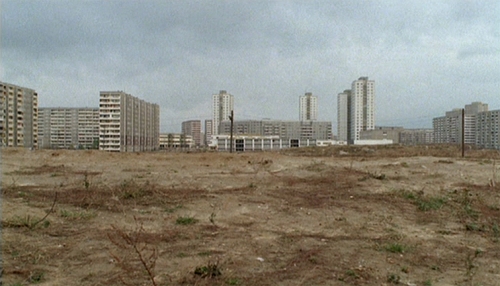The Architects: a film about the reasons for the GDR's collapse

Jenny Farrell discusses The Architects, a film made in 1989/90 which traced the reasons for the collapse of the GDR
30 years ago, on 9 November 1990, the inner-German border was opened, West Berlin was flooded with shoppers, and over the next few days and weeks the East German state toppled and collapsed. Why did it happen?
“The Architects” was one of the last films to be made in the GDR: the shoot began five weeks before the border opened, on 3 October 1989, and continued through to January 1990. It reached the cinemas in June 1990, as the currency union paved the way for the political joining of the two German states. Due to the turmoil of the times this film was viewed by very few; yet it is an interesting artistic document detailing – from the perspective of its artists – the reasons that led to the collapse of the socialist system, as it existed in the German Democratic Republic.
Briefly, the storyline is that a team of young architects is commissioned by the state to design the infrastructure for a vast estate of apartment blocks. They have to contend with the state and party apparatus, economic requisites, a fear of innovation and a lack of imagination. The architects are in their late thirties, the exact age of their country. They studied in Weimar, with all its associations of modern social housing during the Bauhaus and indeed, as referenced in the film, in the GDR itself.
The film follows their struggles to implement their dreams to design a habitable estate, one that does not merely provide the material conditions for survival like accommodation, transport and supermarkets. Their vision is a departure from prefabricated architecture. It is based on non-standard, imaginative elements, ecological construction, a cinema, a Vietnamese restaurant, and recreational facilities. In short, a place where people will be happy to live and stay. It is a metaphor for a society needing to live up to its own vision.
The political critique could hardly be more obvious. Director Peter Kahane said that the screenplay described his own experience as a filmmaker, and the officials deciding on whether or not the film could be made appeared in their own roles in the film itself. Yet despite containing stark criticism of the state, tracing reasons for its collapse, the film was given the go-ahead and given the necessary state funding.
In the film the young team charged with the radical architectural design are cautiously hopeful that they can implement their plans. This is especially true of the team leader, Daniel, who puts up a heroic fight. The arguments used against the team are unconvincing and smack of fear of innovation. Hope is maintained almost to the end, and uncannily continues as everything collapses around them. But it comes too late for the team, and their belief in the project falls to pieces.
Why is this film of interest to us today, 30 years on? Perhaps because the socialist society depicted here shows people who have work and pleasant housing, at least indoors. There is neither poverty nor unemployment or homelessness. There is no evidence of social difference in terms of incomes. From this understanding, from this reality, people wish for more: individuality, imagination, variety. Their main complaint is boredom, paternalism, and an absence of trust. And here they come up against the political powers of the state.
The film is made from a position of achievement. The fact that full employment, cheap social housing for all, free education and medical care, all this social security is not enough, is a statement about the maturity of the society. After our basic human needs are fulfilled, we need cultural centres in the locality, cinemas, restaurants, and architectural art in every neighbourhood. People expect this, and not to have it is rightly seen as deprivation. This is another reason why so many leave the country. What expectations they have for the West and how this pans out is not the focus of the film.
The shoot coincided with people leaving the country in droves, and this is reflected in the film itself. However, Daniel’s Swiss friend, who had studied architecture in Weimar with him, visits because he wants to see the place again. When asked what he is working on, he says refugee accommodation, adding: “We from Weimar are architects with a social conscience.” He has not made money building wacky villas for the wealthy. As it happens, Daniel has the better prospects at that stage of building wacky designs for the working people of the estate.
However, it was not to be, and Daniel loses hope and courage to continue his project, he loses the belief in himself and his ability to change things. The film was overtaken by history in the making, it documented the GDR’s reality as it became history. For me the interest lies not only in its awareness of what went wrong, but also in its lack of awareness of what had gone right.
“The Architects” is available on DVD with English subtitles.

Jenny Farrell
Jenny Farrell is a lecturer, writer and an Associate Editor of Culture Matters.
Latest from Jenny Farrell
- Poetry for the Many, an anthology by Jeremy Corbyn and Len McCluskey
- A hopeful vision of human renewal: the theatre of Seán O'Casey
- Art that's rooted in the upheavals of his time: Caspar David Friedrich, 1774-1840
- A Drive to Change the World: James Baldwin, Black Author, Socialist and Activist
- A woman's perspective on the invisible front: A review of 'The Shadow in the Shadow'
